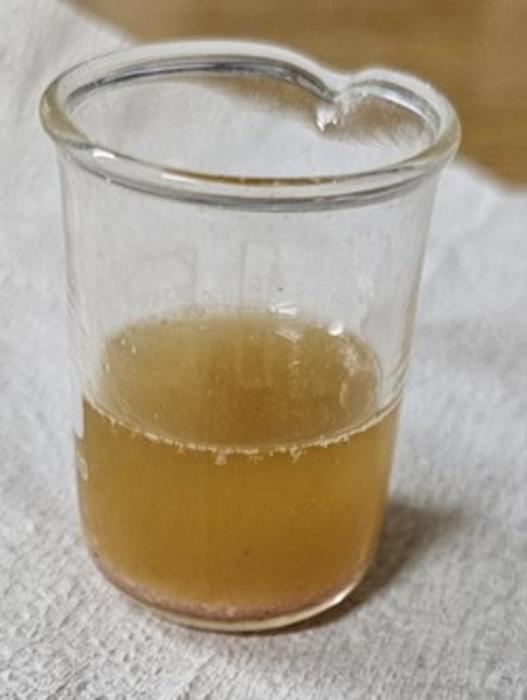Scientists convert chicken fat into energy storage devices
The global move toward more sustainable, green energy has increased power reserves and the demand for energy storage devices. Unfortunately, some materials for these devices can be expensive and environmentally problematic. Producing alternative energy storage devices from things that are usually thrown away could help resolve these challenges. Now, researchers in ACS Applied Materials & […]

The global move toward more sustainable, green energy has increased power reserves and the demand for energy storage devices. Unfortunately, some materials for these devices can be expensive and environmentally problematic. Producing alternative energy storage devices from things that are usually thrown away could help resolve these challenges. Now, researchers in ACS Applied Materials & Interfaces report a method to transform chicken fat into carbon-based electrodes for supercapacitors that store energy and power LEDs.

Credit: Mohan Reddy Pallavolu
The global move toward more sustainable, green energy has increased power reserves and the demand for energy storage devices. Unfortunately, some materials for these devices can be expensive and environmentally problematic. Producing alternative energy storage devices from things that are usually thrown away could help resolve these challenges. Now, researchers in ACS Applied Materials & Interfaces report a method to transform chicken fat into carbon-based electrodes for supercapacitors that store energy and power LEDs.
In 2023, global renewable energy capacity experienced an unprecedented almost 50 percent increase versus the previous year, according to the International Energy Agency. But that excess energy must be stored somewhere for the world to benefit from its production later. For example, sunny days in California have recently triggered negative energy prices due to excess supply from rooftop solar panels. Recent efforts to design high-performance storage devices have taken advantage of carbon materials, such as graphene, because of their efficient charge transportation and natural abundance, but their fabrication is expensive and generates pollution and greenhouse gases. Looking for an alternative carbon source material, Mohan Reddy Pallavolu, Jae Hak Jung, Sang Woo Joo and colleagues wanted to develop a simple, cost-effective method for converting waste chicken fat into electrically conductive nanostructures for supercapacitor energy storage devices.
The researchers first used a gas flame gun to render the fat from a chicken and burned the melted oil using a flame wick method, much as one would use an oil lamp. They then collected the soot on the bottom of a flask, which was suspended above the flame. Electron microscopy showed that the soot contained carbon-based nanostructures that were uniform spherical lattices of concentric graphite rings, like the layers of onions. The researchers tested a way to enhance the electrical characteristics of the carbon nanoparticles by soaking them in a solution of thiourea.
Assembled into the negative electrode of an asymmetric supercapacitor, the chicken fat-sourced carbon nanoparticles demonstrated good capacitance and durability, as well as high energy and power density. As predicted, these properties were improved further when the electrodes were made of the thiourea-treated carbon nanoparticles. The researchers then demonstrated that the new supercapacitor could perform real-time applications — charging and connecting two of them to light up red, green and blue LEDs. The results highlight the potential advantages of using food waste like chicken fat as a carbon source in the search for even greener green energy.
The authors acknowledge funding from the National Research Foundation of Korea through the Regional Leading Research Center (RLRC) for Autonomous Vehicle Parts and Materials Innovation.
###
The American Chemical Society (ACS) is a nonprofit organization chartered by the U.S. Congress. ACS’ mission is to advance the broader chemistry enterprise and its practitioners for the benefit of Earth and all its people. The Society is a global leader in promoting excellence in science education and providing access to chemistry-related information and research through its multiple research solutions, peer-reviewed journals, scientific conferences, eBooks and weekly news periodical Chemical & Engineering News. ACS journals are among the most cited, most trusted and most read within the scientific literature; however, ACS itself does not conduct chemical research. As a leader in scientific information solutions, its CAS division partners with global innovators to accelerate breakthroughs by curating, connecting and analyzing the world’s scientific knowledge. ACS’ main offices are in Washington, D.C., and Columbus, Ohio.
To automatically receive news releases from the American Chemical Society, contact newsroom@acs.org.
Note: ACS does not conduct research, but publishes and publicizes peer-reviewed scientific studies.
Follow us: X, formerly Twitter | Facebook | LinkedIn | Instagram
Journal
ACS Applied Materials & Interfaces
DOI
10.1021/acsami.4c02753
Article Publication Date
24-Apr-2024
What's Your Reaction?

































